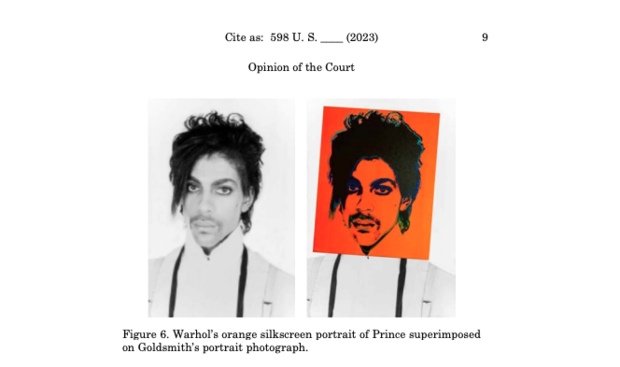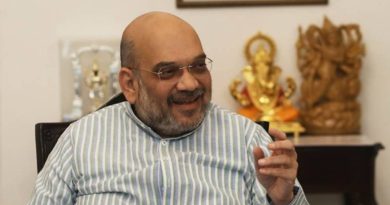Supreme Court rules against Andy Warhol’s estate in copyright dispute over Prince image
Washington — The Supreme Court on Thursday sided with rock-and-roll photographer Lynn Goldsmith in her dispute with the Andy Warhol Foundation over the late artist’s use of her 1981 photo of Prince as the basis for a silkscreen image, finding Warhol infringed on the copyright.
The court split 7-2 in its decision, with Justice Elena Kagan and Chief Justice John Roberts in dissent. In a majority opinion written by Justice Sonia Sotomayor, the court held that the “purpose and character” of the Andy Warhol Foundation’s use of Goldsmith’s photograph in commercially licensing the image known as “Orange Prince” does not favor the foundation’s fair use defense to copyright infringement.
“It will not impoverish our world to require AWF to pay Goldsmith a fraction of the proceeds from its reuse of her copyrighted work,” Sotomayor wrote in an opinion that featured photographs of Prince and Warhol’s work. “Recall, payments like these are incentives for artists to create original works in the first place. Nor will the Court’s decision, which is consistent with longstanding principles of fair use, snuff out the light of Western civilization, returning us to the Dark Ages of a world without Titian, Shakespeare, or Richard Rodgers.”
In a scathing dissent authored by Kagan and joined by Roberts, Kagan praised Warhol as the “avatar of transformative copying” and accused the majority of showing a “lack of appreciation for the way his works differ in both aesthetics and message” from the originals.
In remaking the fair-use test’s first factor and “thus constricting fair use’s boundaries, the majority hampers creative progress and undermines creative freedom,” she said.
At issue in the case was whether Warhol violated federal copyright law when he based a set of 16 silkscreens and sketches on Goldsmith’s black-and-white photo of Prince taken in 1981, when he was an up-and-coming musician.
Three years later, as Prince rose to stardom, Vanity Fair commissioned Warhol to create an illustration depicting Prince that would accompany a magazine article to be titled “Purple Fame.” The magazine chose Goldsmith’s 1981 portrait of Prince to use as “artist reference” for Warhol’s silkscreen, paid Goldsmith a $400 licensing fee and agreed to credit her for the source photograph.
Supreme Court
Warhol ended up creating 16 silkscreens and sketches known as the “Prince Series,” and Vanity Fair ran one of the images, Purple Prince, in its November 1984 issue.
After Warhol’s death in 1987, his foundation took ownership of the Prince Series, and, according to court filings, sold 12 of the 16 originals. The Andy Warhol Museum has the other four.
Prince died in 2016, and Conde Nast, Vanity Fair’s parent company, licensed from the Andy Warhol Foundation an image known as Orange Prince from the Prince Series for the cover of a tribute magazine. The company paid a fee of roughly $10,250 to run the illustration on the cover.
Goldsmith did not receive payment or credit, and she warned the Andy Warhol Foundation of potential copyright infringement.
A federal district court ruled in favor of the foundation, finding in part that Warhol’s Prince Series works are protected by fair use, as the images are “transformative” and the illustrations “wash[ed] away the vulnerability and humanity Prince expresses in Goldsmith’s photographs.” The court also said the licensing market for Warhol and Goldsmith’s works are different.
But the 2nd Circuit disagreed, finding Warhol’s Prince Series was not transformative, and thus not considered fair use, as it retained the “essential elements of the Goldsmith Photograph without significantly adding to or altering those elements.” Judges, the court said, “shouldn’t assume the role of art critic and seek to ascertain the intent behind or meaning of the works at issue.”
In the past, the Supreme Court has allowed fair use if the work is “transformative,” that is, if it “adds something new, with a further purpose or different character, altering the first with new expression, meaning or message.” The law also considers whether the use of a work is for commercial or noncommercial use.
The question before the court in the battle between Goldsmith and Warhol’s foundation was whether the first factor courts consult when a party invokes the fair-use defense under federal copyright law — “the purpose and character of the use, including whether such use is of a commercial nature or is for nonprofit educational purposes” — favored the foundation’s commercial licensing to Conde Nast.
The court said it did not.
“As portraits of Prince used to depict Prince in magazine stories about Prince, the original photograph and AWF’s copying use of it share substantially the same purpose,” Sotomayor wrote. “Moreover, the copying use is of a commercial nature. Even though Orange Prince adds new expression to Goldsmith’s photograph, as the District Court found, this Court agrees with the Court of Appeals that, in the context of the challenged use, the first fair use factor still favors Goldsmith.”
Kagan, though, counters that there is “little evidence” that the seven justices in the majority have “actually looked at these images” Warhol produced of Prince.
“It’s as though Warhol is an Instagram filter, and a simple one at that. ‘What is all the fuss about?,’ the majority wants to know,” she wrote. “Ignoring reams of expert evidence — explaining, as every art historian could explain, exactly what the fuss is about — the majority plants itself firmly in the ‘I could paint that’ school of art criticism. No wonder the majority sees the two images as essentially fungible products in the magazine market — publish this one, publish that one, what does it matter?”
The majority, Kagan said, not only “misconstrues the law,” but “misunderstands — and threatens — the creative process.”



